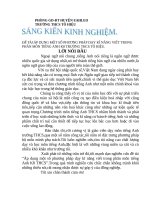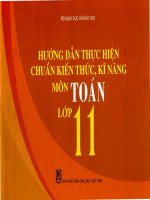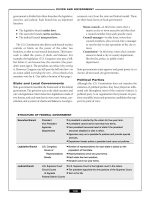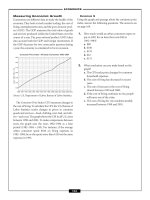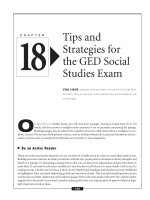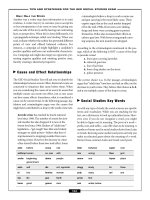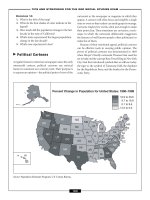kĩ năng viết trong các bài test 1 docx
Bạn đang xem bản rút gọn của tài liệu. Xem và tải ngay bản đầy đủ của tài liệu tại đây (107.61 KB, 6 trang )
The Civil War
Abraham Lincoln, considered by the South to be a threat
to slavery, was elected president in 1860. Eleven southern
states withdrew from the Union. They formed a separate
government called the Confederate States of America.
Here is the division between free and slave states in 1861:
FREE
STATES
Maine Indiana
New Hampshire Illinois
Vermont Michigan
Massachusetts Wisconsin
Rhode Island Iowa
Connecticut Minnesota
New Jersey Kansas
New York Oregon
Pennsylvania California
Ohio
S
LAVE STATES
Maryland South Carolina*
Delaware Georgia*
Virginia* Florida*
Kentucky Alabama*
Missouri Mississippi*
Louisiana* Arkansas*
Texas* Tennessee*
North Carolina*
TERRITORIES
Washington Nevada
Dakota Colorado
New Mexico Utah
Indian Nebraska
*Confederate States
In 1861, Confederate soldiers opened fire on Fort
Sumter in Charleston, South Carolina, and the Civil War
began. The “War Between the States” lasted four years
and eventually killed 600,000 people. It also destroyed an
estimated $5 billion in property. The war ended in 1865
after the surrender of Robert E. Lee, the most important
general of the Confederacy. Four million slaves were
freed during the period of Reconstruction that followed
the war. Five days after the Northern victory, President
Lincoln was assassinated by a Confederate sympathizer.
Resentment and division between the South and North
were not resolved for decades after the war’s end.
Big Business
From 1860 into the next century, the United States expe-
rienced an explosion of industrialization. Just as the
Industrial Revolution changed Europe, it altered life in the
new nation. Natural resources, technological advances,
railroad expansion, and a new wave of immigrants in the
workforce made industrial growth possible. Businesses
began to operate over broad geographic areas and grew
into large corporations. Tycoons of the steel and oil
industry like Andrew Carnegie and John D. Rockefeller
controlled much of the marketplace. The powerful
industrialists supported the policy of laissez-faire: They
believed government should not interfere with business.
Large-scale production changed the workplace.
Laborers were more likely to work in large factories than
in small workshops. Machines and unskilled workers
replaced skilled workers to keep costs down. Many
worked long hours doing monotonous work in danger-
ous conditions. As a result, national labor unions began
to form to protect the rights of workers. The first
national labor union was the Knights of Labor, which
organized in 1869. In 1886, the American Federation of
Labor (AFL) formed, joining together a network of local
unions. Led by Samuel Gompers, an immigrant cigar
maker, the union rallied for improved hours, wages, and
working conditions. Reformers, called the Progressives,
wanted to curb the power of big business and protect
working people. Among other goals, progressive reform-
ers wanted to end child labor and introduce a minimum
wage. Through their efforts, government at the local,
state, and national level began to regulate business.
EXERCISE 5
Use the information from the big business passage to
select the best answer for each question. The answers are
on page 168.
1. Which of the following slogans would industrial-
ist John D. Rockefeller most likely support?
a. Live Free or Die
b. Our Union, Our Voice
c. Equal Pay for Equal Work
d. That Government Is Best Which Governs
Least
e. Big Government
– WORLD HISTORY–
140
2. Which of the following was NOT a goal of the
Progressives?
a. improve workers’ safety
b. stop legislation that restricted business
practices
c. increase government regulation
d. prohibit child labor
e. set a minimum level for wages
The Great Depression
In the 1920s, the country enjoyed a prosperous period.
Business expanded and investors speculated in the stock
market, often borrowing money on easy credit to buy
shares of a company. Money flowed into the stock mar-
ket until October 24, 1929, when the market collapsed.
Investors lost fortunes overnight, businesses started to
close, workers were laid off, and banks closed. The stock
market crash of 1929 marked the onset of the Great
Depression, which lasted through the 1930s. By 1933,
unemployment reached 25%, more than 5,000 banks
were closed, and over 85,000 businesses had failed.
Elected in 1932, President Franklin D. Roosevelt
started a relief effort to revive the economy and bring aid
to people who were suffering the effects of the depres-
sion. He called his program the New Deal. In what is now
called the First Hundred Days, Roosevelt and Congress
passed major legislation that saved banks from closing
and regained public confidence. The following box lists
some of the important measures passed in 1933, the first
year of Roosevelt’s presidency.
The New Deal
Agricultural Adjustment Act—paid farmers to
slow their production in order to stabilize
food prices
National Industrial Recovery Act—outlined
codes for fair competition in industry
Securities and Exchange Commission—
established to regulate stock market
Federal Deposit Insurance Corporation—
insured bank deposits in the case that banks
fail
Public Works Administration—built roads,
public buildings, dams
Tennessee Valley Authority—brought electric
power to parts of the Southeast
Although the New Deal brought relief, it did not end
the Depression. The economy did not revive until the
nation entered World War II in the 1940s. However, the
New Deal had long-lasting effects. It expanded the pow-
ers of the central government to regulate the economy,
and it created “safety-net” programs that would assist
citizens.
– WORLD HISTORY–
141
N THIS CHAPTER, you will learn about the basic ideas of civics (the rights and responsibilities of citizens)
and government (the way that political power is organized and distributed). After an overview of the dif-
ferent types of political systems that exist in other countries, you will review the American system of gov-
ernment: its structure at the federal, state, and local levels; voting and election procedures; political parties; and
the process of becoming an American citizen.
Political Systems
Varying types of political systems can be found around the world. These types differ in how power is attained and
how it is used. See the chart on the next page.
CHAPTER
Civics and
Government
THE PERCENTAGE of civics and government questions on the
2002 GED was greater than in any previous year. The material on the
Social Studies Test will come from both national (American) and global
contexts, so it will be to your advantage to be prepared to answer a
wide variety of questions.
15
143
TYPE OF
GOVERNMENT CHARACTERISTICS EXAMPLES
Monarchy
■
One person from a royal family is ruler.
■
Saudi Arabia
■
Power is inherited from generation to generation.
■
Morocco
■
Absolute monarchs have complete authority. Absolute monarchy:
■
Swaziland
■
Constitutional monarchs have limited authority; Constitutional
a representative democracy governs. monarchies:
■
Great Britain
■
Japan
■
Sweden
Dictatorship
■
It is ruled by one leader who has absolute power over many
■
Nazi (National
aspects of life, including social, economic, and political. Socialist) govern-
■
Leader is not elected by the people. ment of Adolf Hitler
■
General Augusto
Pinochet in Chile
from 1973–1990
Oligarchy
■
It is governed by a small upper-class group.
■
City-state of Sparta
■
Leaders are not elected by the people. in ancient Greece
Democracy
■
In direct democracy, decisions are made by the people. Representative
■
In representative democracy, people elect officials to democracies:
represent their views.
■
United States
■
Canada
■
Most European
nations
– CIVICS AND GOVERNMENT–
144
EXERCISE 6
Use the information from the chart to answer the fol-
lowing questions. The answers are on page 168.
1. A military leader uses his power to overthrow a
country’s government and names himself the
absolute leader of the government. He takes over
all the nation’s television stations and newspa-
pers. What kind of government has he set up?
a. absolute monarchy
b. dictatorship
c. oligarchy
d. direct democracy
e. representative democracy
2. In which of the following political systems would
citizens have the most influence over lawmaking?
a. absolute monarchy
b. dictatorship
c. oligarchy
d. direct democracy
e. representative democracy
The American System of
Government
The United States is a federal republic—a representative
democracy in which power is split between a central
government and the states. To ensure that power is not
concentrated in one authority, the central, or federal,
government is divided into three branches: the legislative,
executive, and judicial. Each branch has an important
function:
■
The legislative branch makes laws.
■
The executive branch carries out laws.
■
The judicial branch interprets laws.
The U.S. Constitution also allows each branch to place
controls or limits on the power of the other two
branches, so that no one branch dominates. This frame-
work is called the system of checks and balances. For
example, the legislature (U.S. Congress) may pass a bill,
but before it can become law, the executive (the presi-
dent) must sign it. The president can refuse it by vetoing
it. However, Congress can still pass the bill into law—in
an action called overriding the veto—if two-thirds of its
members vote for it. (See table at bottom of this page.)
State and Local Governments
State governments resemble the framework of the federal
government. The governor acts as the chief executive and
can veto legislation. Most states have legislatures made of
two houses, and each state has its own court system, con-
stitution, and a system of checks and balances. Local gov-
ernments vary from the state and federal model. There
are three basic forms of local government:
Mayor-council—in this form, voters elect a
mayor as city or town executive and they elect
a council member from each specific ward.
Council-manager—in this form, voters elect
council members, who, in turn, hire a manager
to run the day-to-day operations of the city or
town.
Commission—in this form, voters elect commis-
sioners to head a city or county department,
like the fire, police, or public works
department.
State governments must approve and grant power to, or
charter, all town and city governments.
Political Parties
Although the U.S. Constitution does not mention the
existence of political parties, they have played an influ-
ential role throughout most of the country’s history. A
political party is an organization that presents its posi-
tions on public issues and promotes candidates that sup-
port its point of view.
– CIVICS AND GOVERNMENT–
145
STRUCTURE OF FEDERAL GOVERNMENT
Executive Branch President
■
A president is elected by the voters for four-year term.
Vice President
■
A president cannot serve more than two terms.
Agencies
■
Vice president becomes head of state if the president
Departments becomes disabled or dies in office.
■
Agencies carry out a president’s policies and provide special
services.
■
Department heads advise a president and carry out policies.
Legislative Branch U.S. Congress:
■
Number of representatives for each state is based on the
House of population of that state.
Representatives
■
Representatives serve two-year terms.
Senate
■
Each state has two senators.
■
Senators serve six-year terms.
Judicial Branch U.S. Supreme Court
■
U.S. Supreme Court is the highest court in the nation.
Circuit Courts
■
The president appoints the nine justices of the Supreme Court.
of Appeals
■
Term is for life.
Federal District Courts


